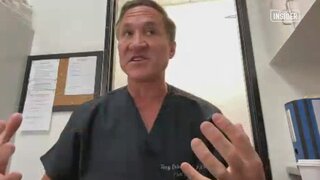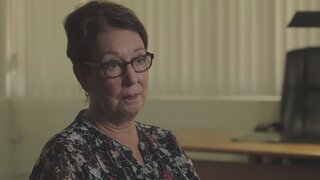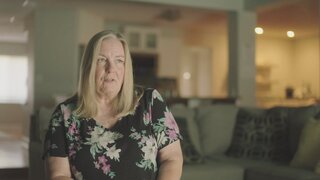Create a free profile to get unlimited access to exclusive videos, breaking news, sweepstakes, and more!
Florida Nurse Injects His Crush With Fatal Dose Of Anesthesia Medication, Flees The Country
Oliver O’Quinn later admitted that he murdered 24-year-old college student Michelle Herndon because “she put him down.”
When college student Michelle Herndon began suffering from debilitating migraines, she looked everywhere for a cure. But not even medication, herbal remedies, and multiple trips to the doctor's office helped relieve her pain.
It was not until Michelle met a local nurse named Oliver O’Quinn that she found a treatment to alleviate her continuous headaches.
What started out as a miracle cure, however, soon resulted in her death, and it would take years — and an international manhunt — until her killer was brought to justice.
In the early morning hours of Nov. 10, 2005, police in Gainesville, Florida were called to Michelle’s home after her boyfriend, Jason Dearing, reported that he had been unable to get in touch with her for several days.
While her front door was locked, Michelle’s dog, Duke, could be seen through the window barking, and every time Dearing called her cell phone, he could hear it ringing inside the house. Her car was also still parked at the home.
When authorities entered the house, they found Michelle deceased on her bed. There were no signs of a struggle, trauma to her body, or any other indication why the healthy 24-year-old would be dead, according to “License to Kill,” airing Saturdays at 6/5c on Oxygen.
Finding no evidence of forced entry, investigators suspected the assailant was someone Michelle had known because they had also locked up the home when they left.
Her remains were immediately taken for an autopsy, and later that day, it was revealed she did not die of natural causes, such as heart failure or an aneurism. A needle mark, however, was found on her left arm.
“The medical examiner thought that this injury was done by somebody with medical training because there was no redness or bruising around the site,” retired Gainesville Police Department crime scene investigator Marc Woodmansee told “License to Kill.”
Michelle’s mother, Belinda Herndon, told investigators that Michelle was afraid of needles and would never sell her plasma or donate blood. To determine what had been injected into Michelle’s blood stream, authorities ordered a toxicology screening, which can take up to weeks and even months to process.
In the meantime, investigators returned to Michelle’s home to go over the crime scene.
“One of the first things we noticed was that Michelle’s bathroom trash was missing out of the house. The trash can was empty, and there was no bag in it. That appeared to have been cleaned out, so went to check the trash dumpsters located adjacent to the property down a dirt alley,” Woodmansee told producers.
In one small grocery bag, there were “pharmacy grade pharmaceuticals,” a blood-stained syringe, and small vials of injectable medicine, including propofol, midazolam, and etomidate. Discarded mail addressed to Michelle was also inside the bag.
Speaking with investigators, Michelle’s landlord, Peter Alcorn, said that on Nov. 7, 2005, he went to pick up some tools that he had left at her house. When he knocked on the door, a young man with dark hair and glasses answered, and he told Alcorn that it was not a good time and to come back later.
Later that day, Michelle called Alcorn to tell him that everything was OK, explaining that she had a friend in town who had given her some good medication for her migraine.
Hoping to learn more about this mystery man, police interviewed Michelle’s best friend, Jessica Seipel, who said that Michelle wasn’t expecting any out-of-town visitors, but that she sometimes hung out with Seipel’s roommate, Oliver O’Quinn.
“I know that he kind of had a thing for Michelle, and I know Michelle had no interest in him. But he always like, he would do things like call Michelle his friend. And I would get, you know, ‘What do you mean your friend? I’m the one that introduced you two.’ He’s just weird,” Seipel said in an interview with police.
Seipel said that O’Quinn was a nurse in the surgical intensive care unit at the University of Florida Health Shands Hospital, meaning O’Quinn had the training to perform injections.
She also revealed that on one occasion, she went into O’Quinn’s bedroom, and on the top of his nightstand, she saw multiple syringes. One was bloody and had its safety cap removed.
“Oliver seemed smitten with Michelle, and he would kind of follow her around like a little puppy dog. Michelle kind of befriended him but kept him at arm’s length. I knew I needed to find Oliver O’Quinn,” Gainesville Police Detective Michael Douglas told “License to Kill.”
Investigators repeatedly tried to get into contact with O’Quinn, but after multiple calls went unanswered, they went to Shands Hospital to speak with his supervisor. She said that O’Quinn had been fired on November 9, the day of Michelle’s death, because he did not have the skills necessary to work in the ICU.
Authorities learned that many of the hospital’s pharmaceuticals were dispensed through Omnicell, a medical vending machine that disburses various patient medications to employees by using their ID codes.
“We were able to connect the lot numbers on the vials in the trash bag back to Shands Hospital, and to last being checked out by Oliver O’Quinn,” Woodmansee told producers.
O’Quinn’s supervisor also said that he worked part-time in the emergency room at Nature Coast Regional Hospital in nearby Williston. Det. Douglas made his way there, and once at the hospital, he found O’Quinn, who matched the description of the man spotted by Michelle’s landlord, working.
When Det. Douglas asked him to sit down for an interview, O’Quinn said he would contact him later to schedule the sit-down before he left on a weeks-long vacation.
Days later, however, there was still no word from O’Quinn, and Det. Douglas returned to the hospital, where O’Quinn’s supervisor said he was scheduled to work but had not shown up.
As authorities tried to track him down, Michelle’s toxicology report came back from the lab.
“It was determined that she had more than four times a lethal dose of propofol in her system. At that quantity, Michelle Hernon would have been unconscious and not breathing in a matter of seconds after this going into her blood … On multiple days leading up to Michelle Hernon’s death, and even on the day of her death, Oliver O’Quinn had withdrawn propofol from that Omnicell machine,” prosecutor James Colaw told “License to Kill.”
Investigators then learned that O’Quinn had left the country on a flight to Ireland on Nov. 29, 2005, and they placed a trace on his passport and contacted the Department of Justice to initiate his extradition.
Two months later, there was little movement in the case, and Sean O'Driscoll, an Irish journalist who had read about the investigation, contacted Det. Douglas and asked how he could help move the inquiry forward.
“He agreed that he would publish a picture of Oliver and Michelle and a synopsis of the investigation, saying that there were active warrants for a murder in the United States for Oliver O’Quinn,” Det. Douglas told producers.
Their attempt to spook O’Quinn worked — The International Criminal Police Organization (INTERPOL) reported that O’Quinn had left Ireland, but they could not disclose where he had fled.
It wasn’t until June 6, 2006 that the United States Marshall service called Det. Douglas and notified him that O’Quinn had shown up at the embassy in Mauritania attempting to pick up a money order.
He escaped a second time, however, and crossed the border on foot to the neighboring country of Senegal, where he was apprehended by local authorities and deported to the U.S.
That October, he was taken into custody by the Gainesville Police Department for Michelle’s murder. While O’Quinn refused to speak with investigators without a lawyer, a court order allowed authorities to collect a sample of his DNA to test against the evidence found at the crime scene.
The results showed that the blood that was found within the syringe had a profile that matched Michelle, and on the cap of the syringe, there was a DNA profile that matched O’Quinn.
As authorities prepared the case for trial, O’Quinn’s cellmate, Thomas Rauscher, told law enforcement that O’Quinn had admitted to murdering Michelle. Rauscher claimed that O’Quinn said he had killed her after overhearing a conversation between her and her boyfriend in which she made “derogatory comments” about him.
“His quote to Thomas Rauscher was that because she put him down, he was going to put her down,” Colaw told producers.
Rauscher testified at O’Quinn’s trial, and in May 2008, he was found guilty of first-degree murder. He was sentenced to life in prison without the possibility of parole.
To learn more about the case, watch “License to Kill" now on Oxygen.com.
























